Rebounders burn more calories than treadmills because they create variable G-forces that engage more muscle fibers simultaneously. NASA research found rebounding is 68% more efficient than running, with multi-directional movements activating your core stabilizers and improving balance. The bouncing motion also stimulates your lymphatic system while reducing joint impact, allowing for longer workouts with less perceived exertion. Discover how this simple equipment change could dramatically boost your fitness results.
The NASA Study That Changed Exercise Science
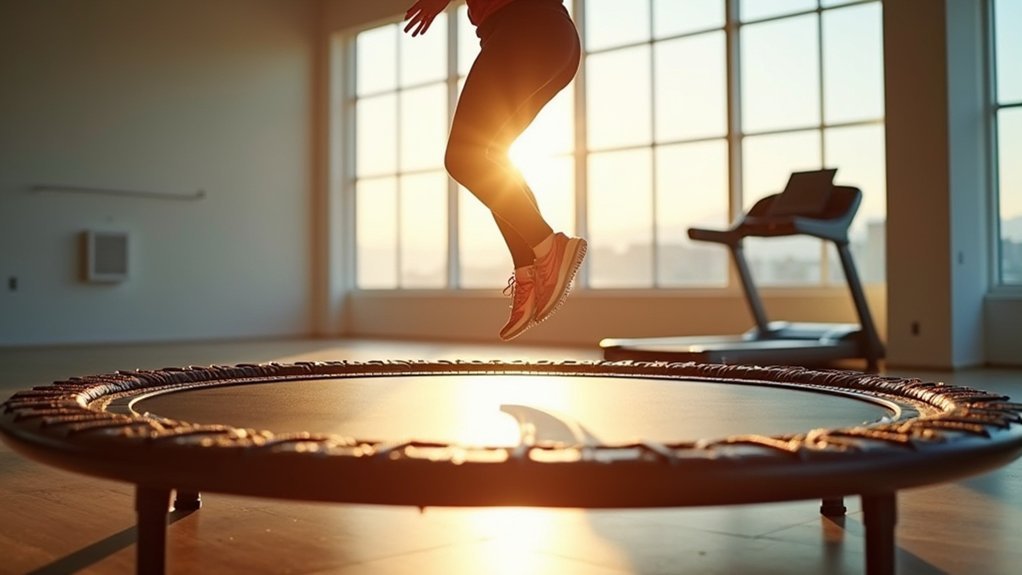
When NASA scientists faced the challenge of preventing muscle and bone loss among astronauts in 1980, they inadvertently revolutionized exercise science for everyone on Earth.
Their groundbreaking study compared traditional treadmill running with rebounding on mini-trampolines.
The results were stunning: rebounding matched running’s oxygen uptake but with 68% greater efficiency.
While running concentrated stress at the ankles, rebounding distributed G-forces evenly throughout your body.
Most impressively, 10 minutes on a rebounder delivered cardiovascular benefits equivalent to 30 minutes of running.
Rebound your way to triple-efficiency workouts — get a half-hour’s cardio benefits in just 10 minutes.
This research validated rebounding as not just a space-worthy exercise but a superior option for anyone seeking efficient workouts.
Rebounding provides an effective workout with less strain on the body while still challenging muscles and cardiovascular systems.
The findings transformed physical therapy programs and created an entirely new fitness category that continues to grow in popularity today.
Breaking Down the Calorie Numbers: Rebounders vs. Treadmills
Despite the growing popularity of rebounders, many fitness enthusiasts still wonder if these bouncy platforms can truly compete with treadmills for calorie burning. The numbers tell a compelling story: a 30-minute rebounding session burns approximately 234 calories compared to 218 calories when running for the same duration. A NASA study confirmed that rebounding is more efficient than traditional running workouts for cardiovascular fitness.
| Comparison Factor | Rebounding | Treadmill Running |
|---|---|---|
| 30-Minute Session | 234 calories | 218 calories |
| 40-Minute Session | 405 calories | 380 calories |
| Impact Level | Low-impact | High-impact |
| Muscle Engagement | Multiple groups | Primarily lower body |
| Enjoyment Factor | Higher reported fun | Variable enjoyment |
You’ll burn more calories on a rebounder while experiencing less joint strain. The dynamic G-force fluctuations and varied movements engage more muscle groups, making your workout both more efficient and entertaining.
How G-Force Fluctuations Amplify Your Calorie Burn

G-force fluctuations during rebounding push your muscles to work harder with each bounce, engaging more muscle fibers than the consistent motion of treadmill running.
Your body experiences a peak-to-valley metabolic effect as you shift between weightlessness and increased gravitational pull, forcing your systems to rapidly adapt and burn additional calories. This constant fluctuation creates an elevated G-Flux relationship between energy intake and expenditure, optimizing your body’s calorie turnover efficiency.
These constant gravitational changes create micro-adjustments in your muscles and core, requiring extra energy expenditure that wouldn’t occur during the more predictable impact patterns of treadmill exercise.
G-Force Muscle Activation
Although many exercisers focus primarily on duration and intensity, the often-overlooked factor of G-force dramatically impacts your workout’s effectiveness.
When you rebound, your body experiences varying G-force levels that trigger deeper muscle recruitment patterns than steady-state treadmill walking.
These fluctuations create mechanical stress that forces your muscles through intense contraction and relaxation cycles. Your body responds by activating a broader range of muscle fibers—including stabilizing muscles that typically remain dormant during consistent movements. Research consistently demonstrates that higher G-forces correlate with enhanced neuromuscular activation and training efficacy.
This enhanced neuromuscular stimulation explains why rebounding can burn approximately 10 calories per minute. Your body works harder against changing forces rather than the predictable resistance of a treadmill.
The dynamic G-force environment not only burns more calories during exercise but also elevates your metabolic rate afterward, making rebounders considerably more efficient for calorie burning.
Peak-to-Valley Metabolic Effect
When your body experiences the alternating peak and valley phases during rebounding, it triggers a unique metabolic response that traditional treadmill workouts simply can’t match.
Unlike the steady-state exercise of treadmill running, rebounding creates fluctuating intensities that mimic interval training. These G-force variations require your muscles to rapidly contract and relax, greatly increasing energy consumption.
Your body must constantly decelerate and accelerate, engaging multiple muscle groups simultaneously and creating beneficial metabolic stress. This process enhances lactate management, improves fat metabolism, and increases insulin sensitivity.
Research shows that interval-style training like rebounding may be more effective for cardiometabolic health in overweight adults than continuous endurance exercises, with interval training demonstrating significant effects on various health markers.
While treadmills maintain consistent intensity, your rebounder naturally incorporates high and low-intensity phases within seconds.
This fluctuation not only burns more calories during your workout but also promotes greater post-exercise metabolic activity – giving you more caloric bang for your exercise buck.
Multi-Directional Movement: The Secret Calorie-Burning Advantage
Unlike traditional linear exercises, rebounding on a mini-trampoline offers a unique advantage through multi-directional movement patterns. When you’re on a rebounder, you’re not just moving up and down—you’re jumping, twisting, and pivoting in various directions, engaging multiple muscle groups simultaneously.
This extensive muscle recruitment requires more energy expenditure than the repetitive forward motion of treadmill running. Your core stabilizers work overtime to maintain balance while your body responds to changing G-forces with each bounce. NASA research confirms that rebounding can be up to 68% more effective than jogging at similar speeds.
The dynamic movements challenge your coordination and enhance your body’s calorie-burning efficiency. While treadmills lock you into a single plane of movement, rebounding’s multi-directional nature creates a more effective workout that’s gentler on your joints.
You’ll burn more calories while having so much fun you won’t even notice how hard you’re working.
Weight Factors: Why Body Mass Matters on a Rebounder
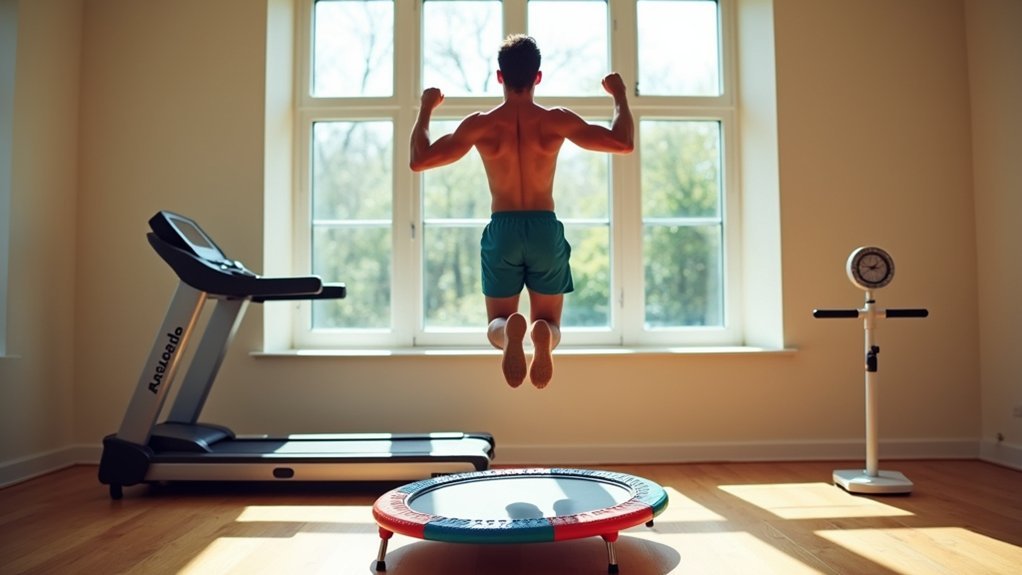
Your weight directly impacts how many calories you’ll burn during a rebounding session, with heavier individuals expending more energy due to increased resistance against gravity.
When you’re carrying more body mass, each bounce requires greater effort, transforming even moderate-intensity sessions into high-calorie-burning workouts. This explains why Sydney burned 234 calories during her 30-minute rebounding test, which was more than her running session.
This weight-based advantage means you’ll see more efficient results compared to lighter individuals performing the same exercises for the same duration.
Weight Multiplies Caloric Output
Body mass fundamentally influences how many calories you’ll burn during a rebounding session. If you’re carrying more weight, you’ll naturally expend more energy with each bounce as your body works harder against gravity.
This physics-based advantage means larger individuals can burn considerably more calories while performing the same rebounding routine as someone lighter. Our study clearly demonstrated this when Alex, at 208 pounds, burned nearly twice as many calories as Sydney at 128 pounds during identical workouts. Your body requires additional energy to move greater mass through space, creating a compounding effect on caloric expenditure.
When you combine increased body weight with higher intensity rebounding exercises, you’ll maximize your caloric burn potential.
While heavier individuals burn more absolute calories, the relative effort feels similar across weight ranges. This makes rebounding an excellent option if you’re looking to leverage your current weight to accelerate fitness results.
Resistance Increases With Size
When you step onto a rebounder, physics immediately goes to work, creating a direct relationship between your weight and resistance. Each time you bounce, your body mass amplifies the workload as gravity pulls you down and the springs propel you back up.
The science behind this weight-resistance relationship is straightforward:
- Greater mass requires more energy – Your body needs additional calories to move heavier weight against gravity.
- Increased spring compression – More weight creates stronger elastic resistance from the rebounder.
- Enhanced muscle engagement – Heavier bodies activate more muscle fibers to control movement.
- Scalable caloric burn – As your weight increases, so does your energy expenditure, making rebounding increasingly efficient.
This natural resistance scaling makes rebounding uniquely effective for people of all sizes, offering automatic workout customization without adjustment settings. This efficiency explains why a 150-pound person burns 82 calories jumping on a trampoline versus only 71 calories jogging, demonstrating the calorie burning advantages of rebounding exercise.
The Lymphatic System Boost You Don’t Get From Running
While running on a treadmill provides excellent cardiovascular benefits, it fails to deliver the same lymphatic system stimulation as rebounding. Your lymphatic system lacks a pump like your heart, instead relying on muscle contractions to move toxins and excess fluids out of your body.
Rebounding’s repetitive bouncing creates a unique gravitational effect that compresses and releases muscles throughout your entire body. This gentle pumping action stimulates lymphatic flow more effectively than running, which primarily engages lower body muscles.
The repetitive up-and-down motion of rebounding acts like a cellular massage, enhancing your immune function and helping prevent diseases associated with fluid retention. Regular rebounding can help maintain a healthy weight, which is critical for optimal lymphatic system functioning.
If you’re recovering from illness or managing lymphedema, this lymphatic boost becomes even more valuable than the calorie burn alone.
HIIT on a Rebounder: Maximizing Afterburn Effects
The afterburn effect—technically known as Excess Post-exercise Oxygen Consumption (EPOC)—sets rebounder workouts apart from standard treadmill routines.
Your body continues burning calories for up to 48 hours after intense rebounding sessions due to the unique combination of G-force utilization and adaptive resistance.
Maximize your afterburn with these rebounder HIIT strategies:
- 30/30 Sprint Cycles – Alternate 30-second high-intensity movements (tuck jumps, knee lifts) with 30-second recovery periods.
- Compound Movements – Incorporate multi-directional jumps to activate more muscle groups simultaneously.
- Tabata Protocol – Try 20 seconds maximum effort/10 seconds rest for 8 rounds.
- Hybrid Integration – Combine on-mat bouncing with off-mat exercises like burpees for metabolic surges.
For optimal results, practice these HIIT sessions 2-3 times weekly to achieve maximum metabolic benefits while allowing proper recovery.
You’ll achieve RPE 8/10 intensity with considerably less joint stress than treadmill sprints.
Sustainability Factor: Longer Workouts Equal More Calories
Sustainable exercise routines ultimately deliver superior calorie-burning results, and rebounders excel precisely in this area.
With markedly reduced joint impact compared to treadmills, you’ll experience lower injury risk and minimal recovery needs—enabling longer, more consistent workouts.
You’ll find it easier to maintain extended sessions on a rebounder because of reduced perceived exertion, despite comparable heart rates to running. The diverse workout options prevent monotony, keeping you engaged while the immediate feedback from bounce height helps sustain your effort.
The math supports this advantage: at moderate intensity, you can burn approximately 468 calories per hour, with heavier users naturally working harder per bounce.
Since rebounders allow for continuous motion without joint strain, you’ll likely exercise longer and more frequently, maximizing your overall calorie expenditure.
Real-World Results: What Sports Watch Data Reveals
Modern fitness trackers reveal a compelling truth about rebounding: your calorie-burning potential greatly exceeds what you’d achieve on a treadmill.
When you sync your sports watch during rebounding sessions, you’ll notice higher sustained heart rates and increased calorie expenditure compared to running for the same duration.
The data doesn’t lie:
- Rebounding sessions typically show 300-405 calories burned in just 30-40 minutes
- Heart rate patterns during rebounding indicate consistent cardiovascular engagement
- Multiple muscle group activation registers as higher energy expenditure on fitness trackers
- Workout consistency improves with rebounding, as shown by user data patterns
This technology-backed evidence supports what many rebounding enthusiasts have experienced firsthand—you’re getting more calorie-burning bang for your workout buck on a rebounder than a treadmill. Research has confirmed that rebounding is 68% more effective than running for improving cardiovascular health.
Frequently Asked Questions
Can Seniors or Those With Mobility Issues Use Rebounders Safely?
Yes, you can use rebounders safely with mobility limitations. Choose models with stability bars, start with seated exercises, wear non-slip shoes, and maintain proper supervision. Always consult your physician before beginning any new exercise.
How Do Rebounders Compare to Other Low-Impact Exercises Like Swimming?
Rebounders match swimming’s low-impact benefits but offer better bone density maintenance, more convenient workouts, and similar calorie burn. You’ll get superior lymphatic drainage and core engagement, though swimming provides more upper-body conditioning.
Are There Specific Rebounding Techniques to Target Different Body Areas?
Yes, you can target different areas with specific moves: high knees for abs, heel digs for calves, squat jumps for glutes, and arm movements with weights for upper body muscles.
What Features Should I Look for When Purchasing a Quality Rebounder?
Look for sturdy spring or bungee systems, high weight capacity, non-slip mats, and foldable designs. You’ll want a quiet bounce mechanism, replaceable parts, and adjustable tension for progression in your workouts.
How Long Before Seeing Weight Loss Results With Regular Rebounding?
You’ll typically see weight loss results within 12-20 weeks of consistent rebounding (3-5 times weekly). For faster results, aim for 30+ minute sessions at higher intensity and combine with dietary changes.
In Summary
You’ve learned why rebounders outperform treadmills in calorie burning—from NASA’s groundbreaking research to the unique G-force benefits. With multi-directional movement, enhanced lymphatic circulation, and superior HIIT potential, your mini-trampoline workouts aren’t just easier on your joints. They’re scientifically proven to burn more calories while being more sustainable long-term. Your fitness tracker doesn’t lie—rebounding delivers results that traditional cardio simply can’t match.
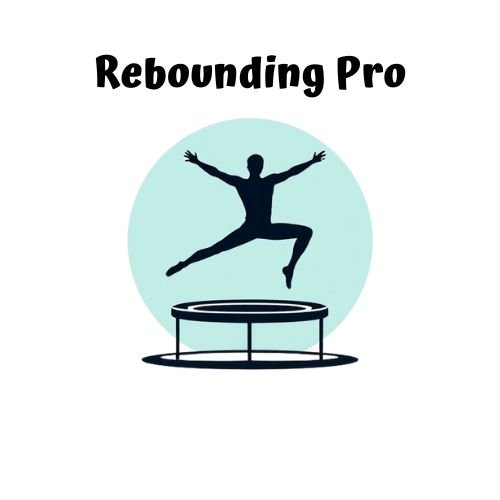
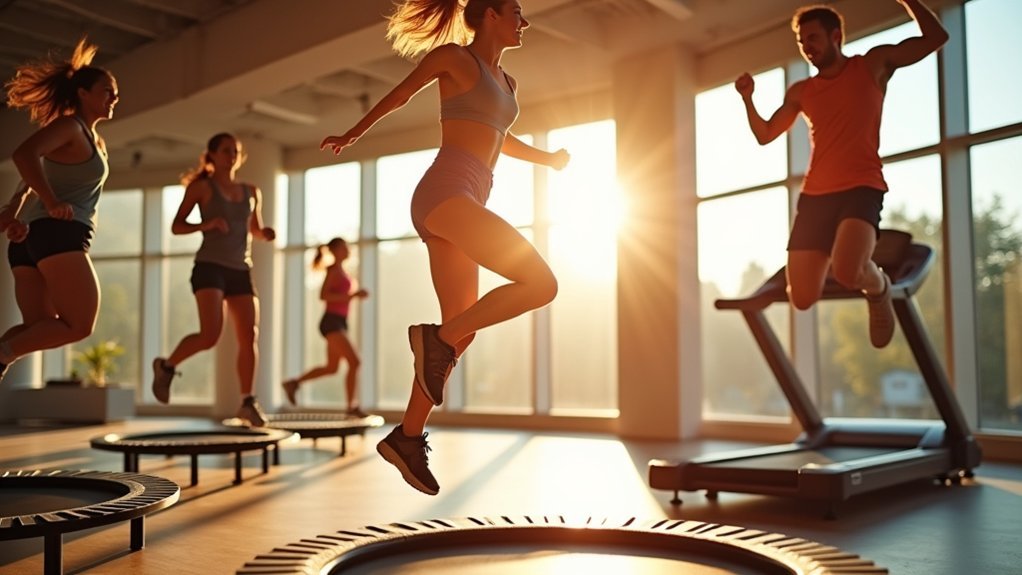


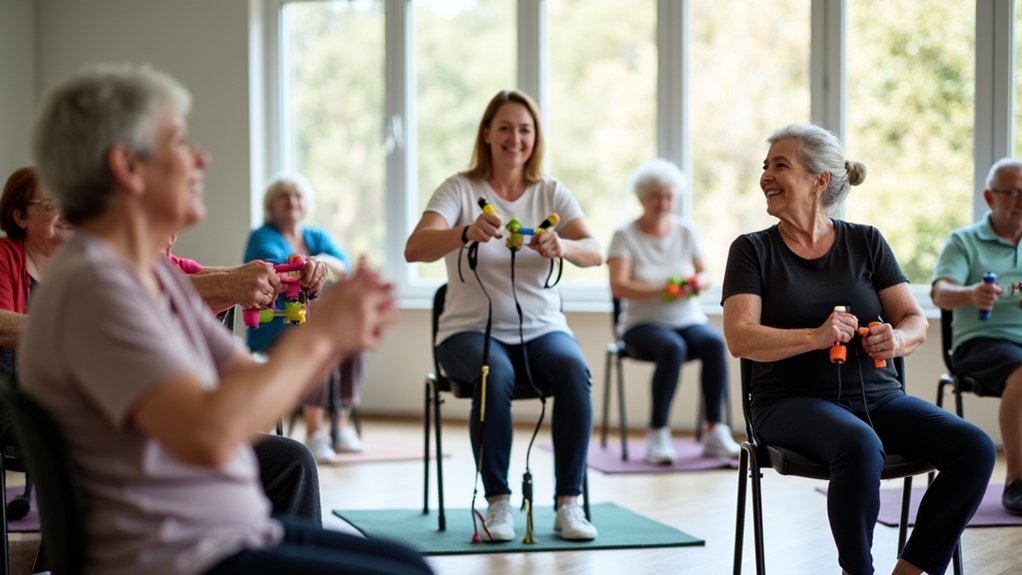
Leave a Reply